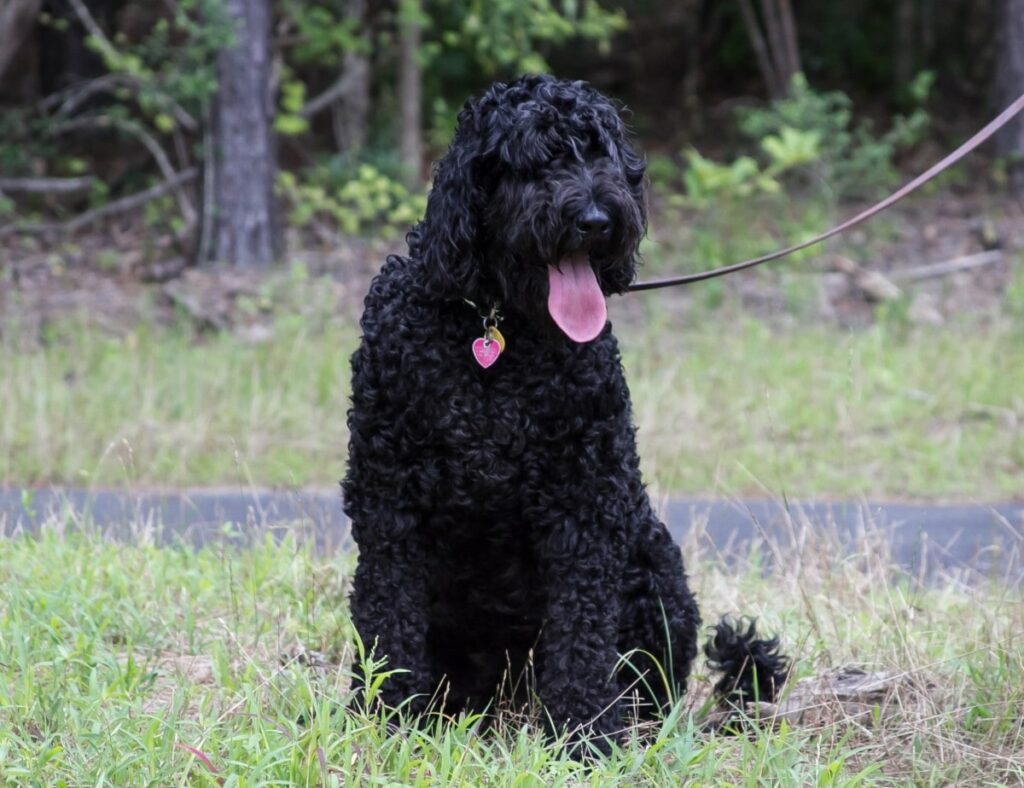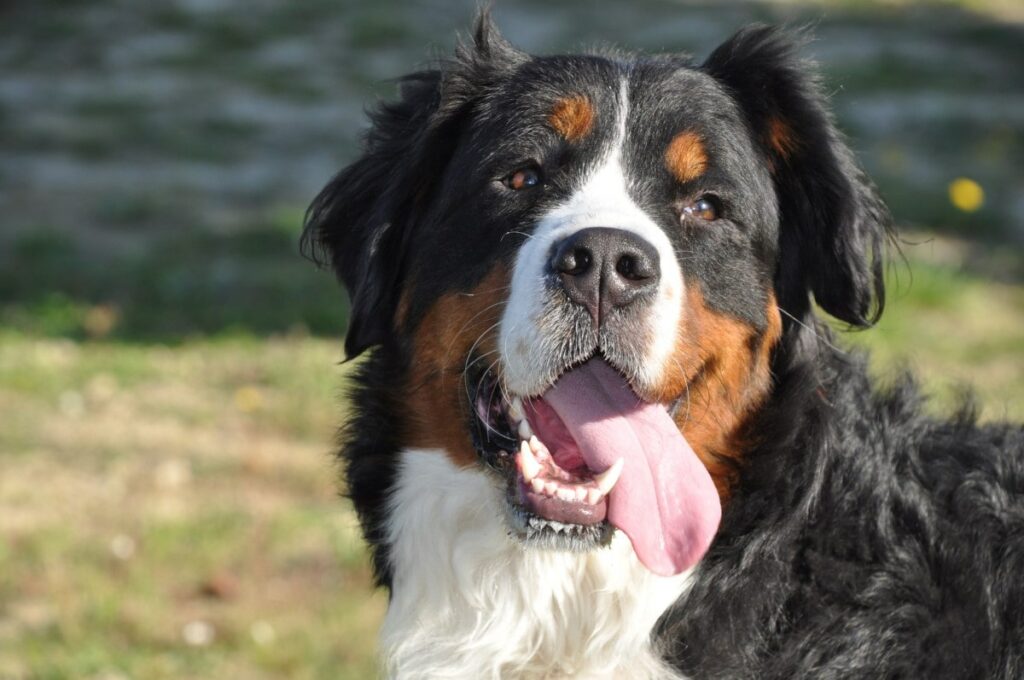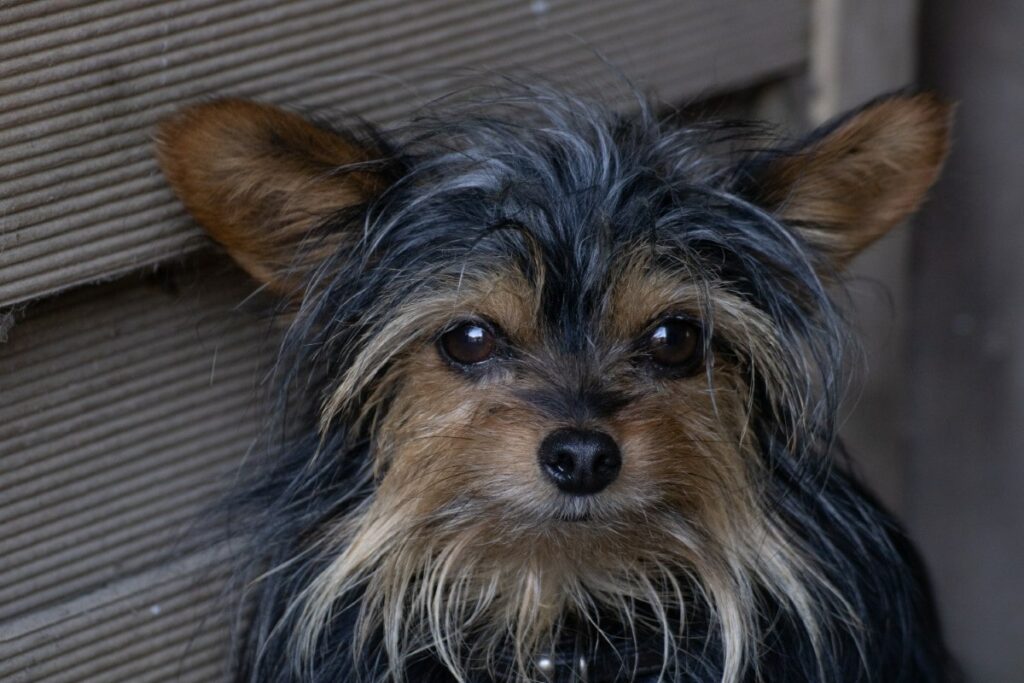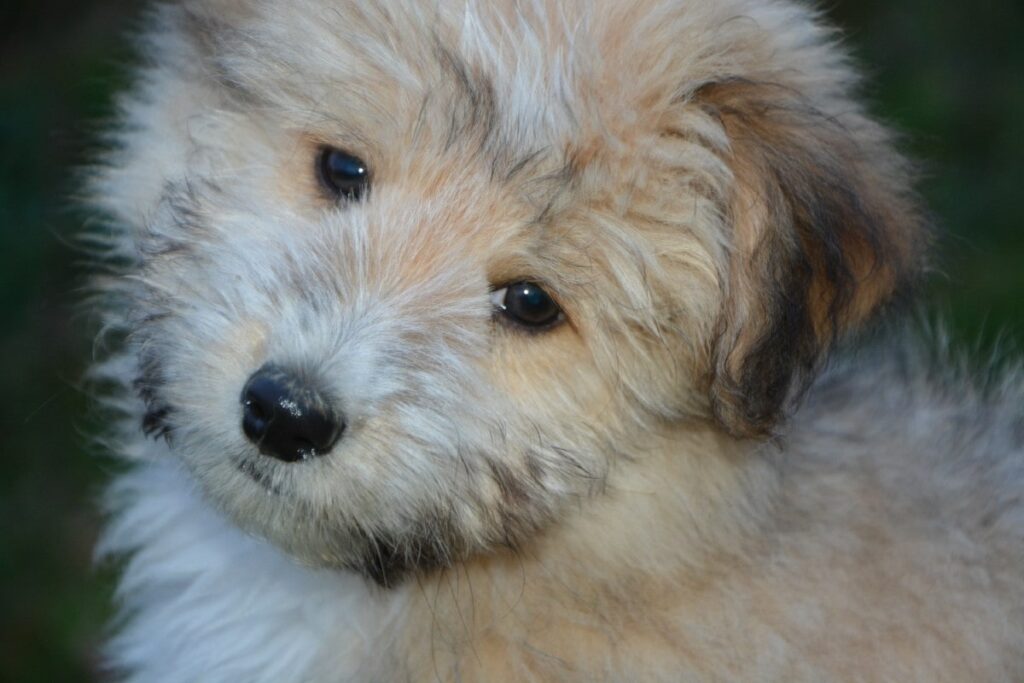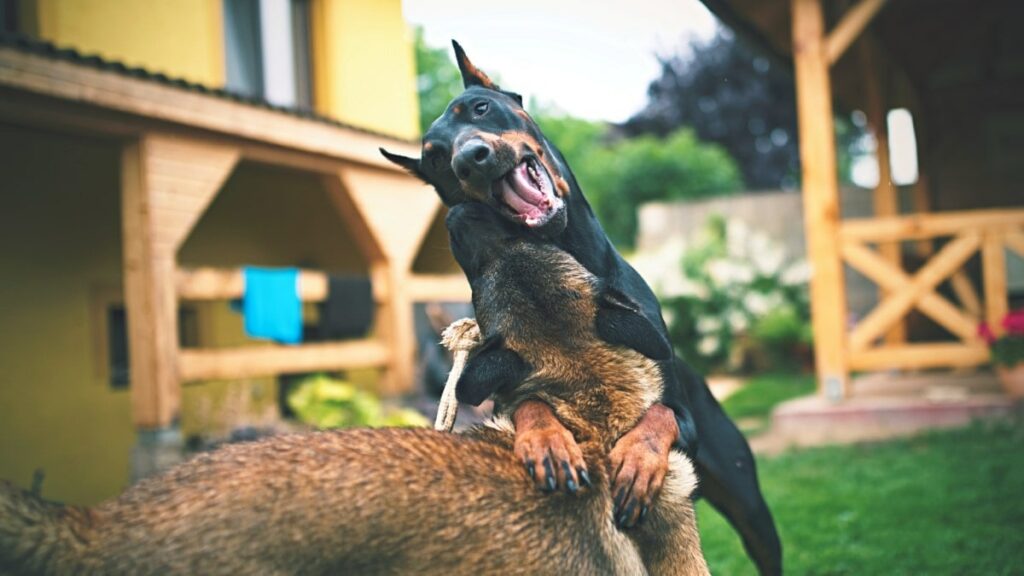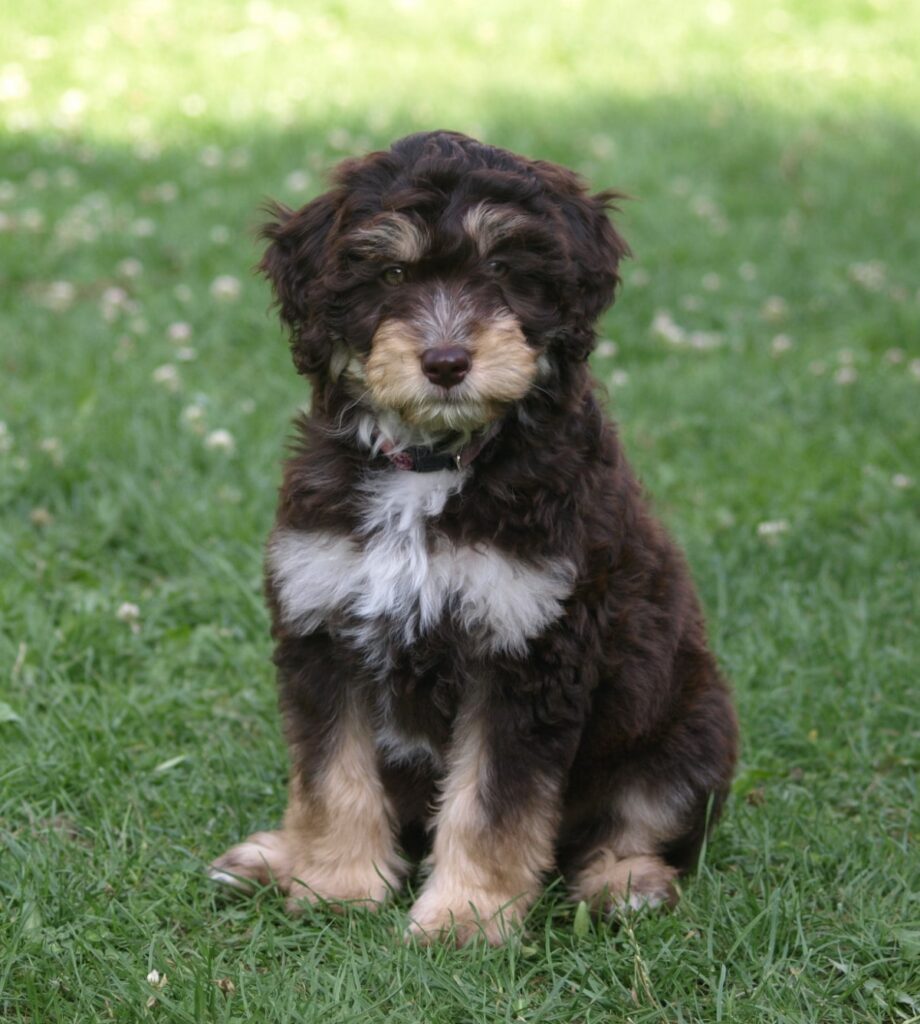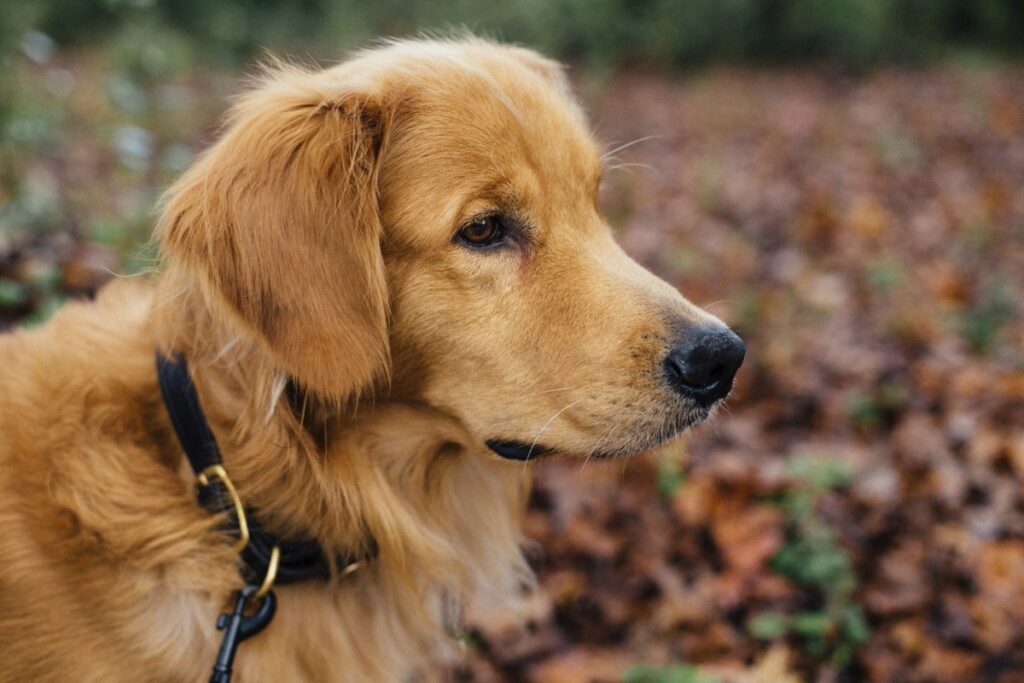A Schnoodle is a cross between a Miniature Schnauzer and a Poodle. The result is a hypoallergenic, low-shedding dog that is intelligent and active. Schnoodles come in three sizes (Standard, Miniature, and Toy) and many colors, including black, white, cream, brown, apricot, and particolored.
Schnoodles are outgoing, friendly dogs that make great family pets. They are good with children and other animals and love to play. Schnoodles are also very intelligent and easily trained. They excel in obedience and agility trials and make excellent therapy dogs.
Schnoodles require moderate exercise – a daily walk or play session is sufficient. They do not do well if left alone for long periods and can become destructive if bored. Schnoodles are relatively easy to groom – they should be brushed regularly and their coat trimmed every few months.
If you are looking for a loving, loyal companion who is also intelligent and easy to train, a Schnoodle may be the perfect dog for you!
How Does Schnoodle Dog Looks Like?
The Schnoodle is a hybrid or designer dog breed created by crossing a Poodle with a Schnauzer. The resulting pup inherits the best traits of both breeds and is suitable for families looking for an active, intelligent, and loving companion. The Schnoodle can come in three different size varieties (Toy, Miniature, and standard) and coat types (wavy, curly, or straight). They typically have a lifespan of 10-12 years and do not require a lot of grooming.
The Schnoodle is an intelligent breed that is easily trained. They are also very active and need plenty of exercises to stay healthy and happy. This breed does best in a home with a backyard where they can run and play. They are loyal companions and make great family dogs.
What Are The History And Origins Of The Schnoodle Dog?
The Schnoodle is a hybrid or designer dog created by crossing a Poodle with a Schnauzer. The first Schnoodles were bred in the 1980s in the United States. They are bred in three sizes, Standard, Miniature, and Giant. The Standard Schnoodle is created by crossing a Standard Poodle with a Standard Schnauzer, the Miniature is created by crossing a Toy or Miniature Poodle with a Miniature Schnauzer, and the Giant is created by crossing a Giant Schnauzer with a Standard Poodle.
- The Standard Schnoodle weighs between 40 and 70 pounds and stands 18 to 20 inches tall at the shoulder.
- The Miniature Schnoodle weighs between 15 and 30 pounds and stands 11 to 16 inches tall at the shoulder.
- The Giant Schnoodle weighs between 80 and 100 pounds and stands 25 to 30 inches tall at the shoulder.
All three sizes have curly, wavy, or shaggy coats that may be any color or combination of colors.
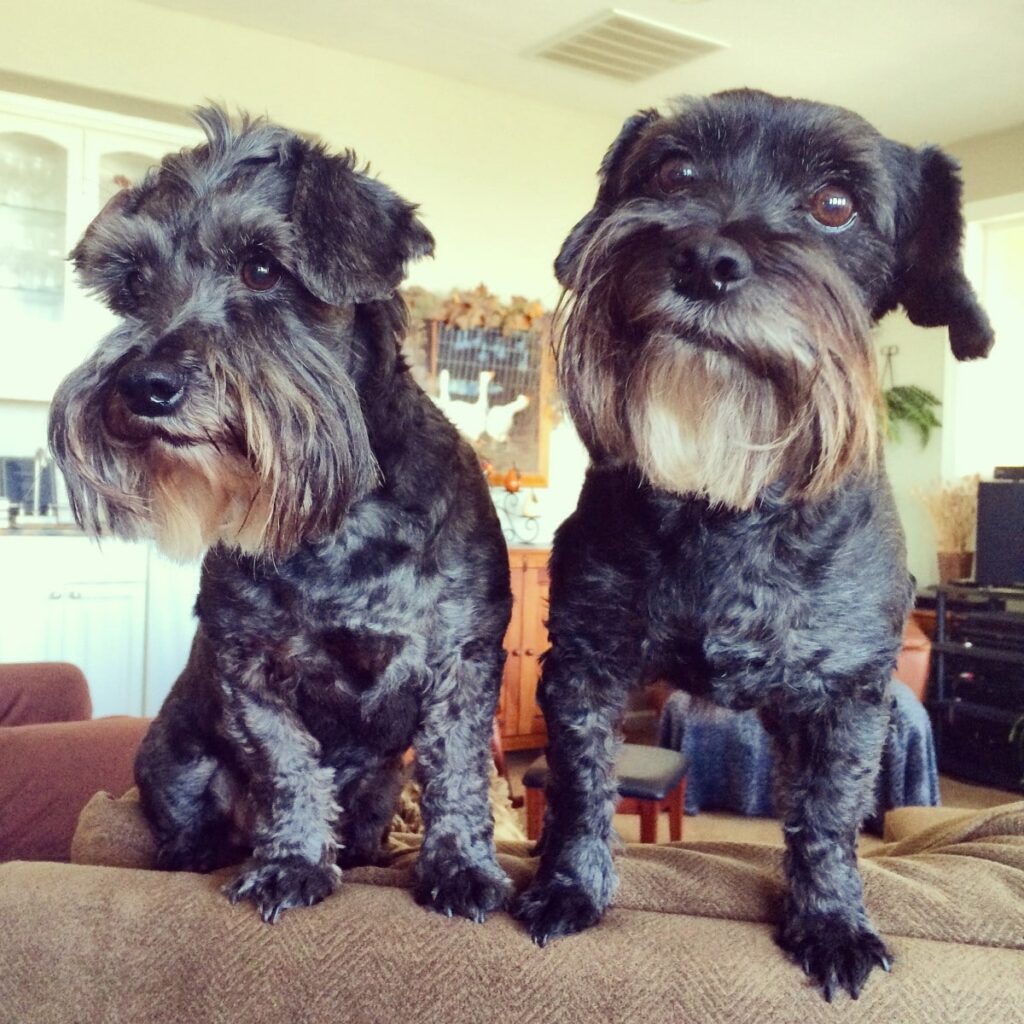
In Which Breed Group Schnoodle Dog Lies?
A Schnoodle is a cross between a Poodle and a Schnauzer. There are three size categories of Schnoodle; Standard, Miniature, and Toy. All three sizes of Schnoodle can be found in either the American Kennel Club’s Non-Sporting Group or the Miscellaneous Class.
The Standard Schnauzer is the breed most often used to create a Standard Schnoodle. This is because the Standard Poodle is too large to safely mate with a Miniature Schnauzer without the help of a professional breeder. The Miniature Poodle is sometimes used to create a Miniature or Toy Schnoodle, but this is less common. Some breeders may also use first-generation Schnoodles (a dog that is half Poodle and half Schnauzer) to create subsequent generations of the same mix.
The coat of a Schnoodle can vary depending on which parent breed they take after most. If they inherit more traits from the Poodle side, they will have a softer and curlier coat. If they take after the Schnauzer side more, their coat will be coarser and wavier. Most Schnoodles will have a coat that falls between these two extremes. Regardless of which parent breed they favor, all Schnoodles will require regular grooming to keep their coats healthy and free of mats and tangles.
How Tall Can Schnoodle Dogs Get?
The Schnoodle can come in three different size varieties, Toy, Miniature, and Standard. Toy and Miniature Schnoodles are usually between 9 and 16 inches tall at the shoulder, while Standard Schnoodles are usually 17 to 20 inches tall. Some Giant Schnoodles have been known to grow as tall as 28 inches at the shoulder, but this is not considered the norm. Most Giant Schnoodles fall somewhere in the range of 23 to 26 inches tall.
What Kind Of Training Is Required For A Schnoodle Dog?
The best way to train a Schnoodle is through positive reinforcement. This means rewarding your dog for good behavior rather than punishing them for bad behavior. You can use treats, toys, or verbal praise as a reward. It is essential to be consistent with your training, as this will help your dog to understand what you expect from them. Start with basic commands such as sit, stay and come, and then move on to more advanced tricks once your dog has mastered these.
Schnoodles are generally healthy dogs, but like all breeds, they can be prone to specific health conditions. These include hip dysplasia, von Willebrand’s disease, and epilepsy. It is essential to speak to your breeder about any health concerns before you purchase a puppy and to have regular check-ups with your vet throughout your dog’s life.
Are Schnoodle Dogs Easy to Train?
Yes, Schnoodle dogs are easy to train. They are brilliant and very eager to please their owners. They respond well to positive reinforcement and are quick learners. However, they can also be stubborn and require patience and consistency when training them.
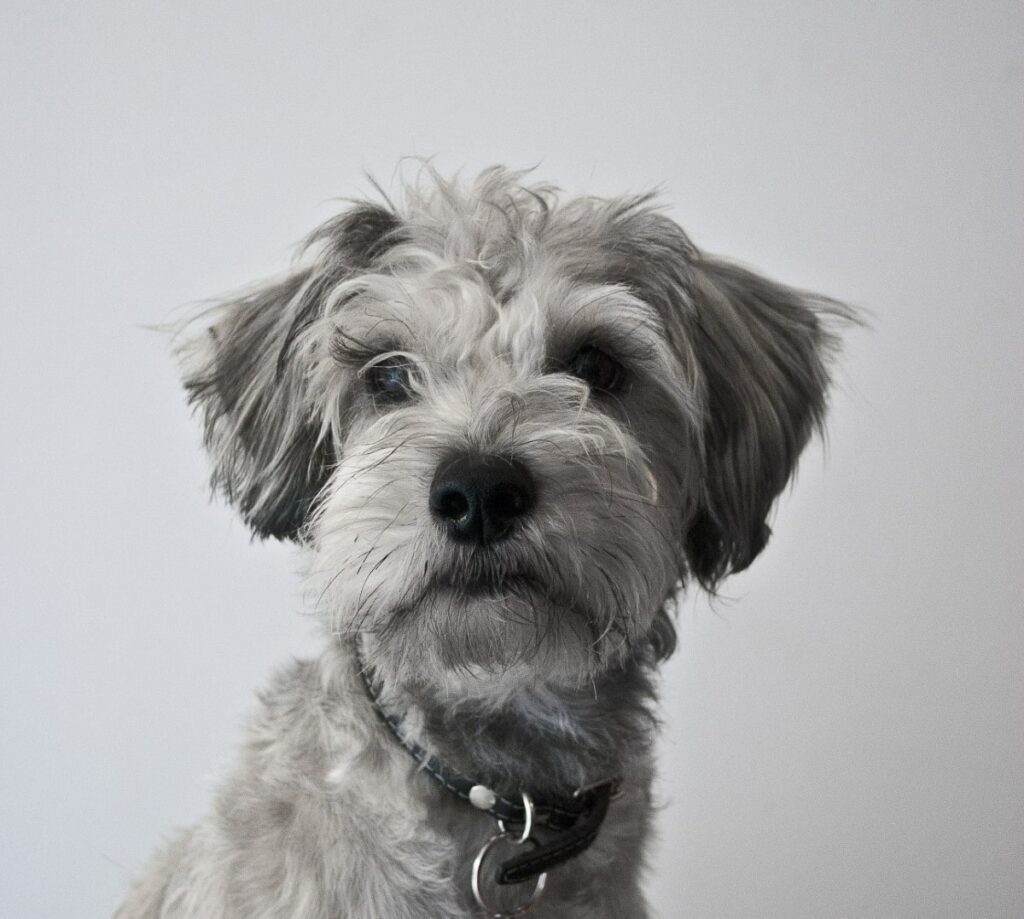
How To Train Your Schnoodle Dog?
A Schnoodle is a cross between a Poodle and a Schnauzer. They are intelligent, active dogs that make great family pets. Schnoodles can be either Standard or Miniature size, and they come in a variety of colors, including black, white, brown, and silver.
Schnoodles are relatively easy to train, but like all dogs, they need patience and consistency from their owners. The best way to train a Schnoodle is with positive reinforcement methods such as treats or praise. Like all dogs, Schnoodles need to be socialized early to ensure they are comfortable around people and other animals.
Here are some tips on how to train your Schnoodle:
- Start with basic obedience commands such as sit, stay, come, down, and heel. Be sure to use positive reinforcement when your dog obeys a command by giving them a treat or verbal praise.
- If you plan on taking your Schnoodle for walks or runs, starting training them on a leash from an early age is essential. Begin by walking around the block or in a park with your dog on a leash. As they get more comfortable walking on a leash, you can increase the distance of your walks.
- Many Schnoodles enjoy learning tricks! Some popular tricks to teach your Schnoodle include shaking hands, rolling over, playing dead, and spinning in circles. Not only are tricks fun for you and your dog, but they also help keep your dog’s mind active and engaged.
- It’s important to continue socializing your Schnoodle even after they’ve reached adulthood. This can be done by taking them to dog parks, doggy daycare, or puppy classes at your local pet store.
With patience and consistency, you can successfully train your Schnoodle to be the well-behaved dog you always wanted!
What Is The Temperament And Personality Of The Schnoodle Dog?
Schnoodles are very people-oriented dogs and love spending time with their families. They are brilliant and easily trained, making them excellent companions for children and adults alike. They are also very active dogs and need plenty of exercises to stay happy and healthy.
While they make excellent pets, Schnoodles are not the right breed for everyone. They require much attention and interaction with their owners and can become destructive if left alone for too long. They also require regular grooming to keep their coat in good condition.
If you are looking for a loving, loyal companion who will always be by your side, the Schnoodle is the perfect dog!
How Long Does a Schnoodle Dog Live?
The Schnoodle is a hybrid dog breed that crosses the Poodle and the Schnauzer. The lifespan of the Schnoodle is typically 10-12 years, though some have been known to live up to 15 years with proper care.
How Much Is A Schnoodle Dog Likely To Weigh?
A Schnoodle can weigh anywhere from 10 to 80 pounds when fully grown. The weight of a Schnoodle will depend on the size of the parents, with Toy and Miniature Poodles producing smaller dogs and Standard Poodles yielding larger ones. Some breeders aim for a specific weight range when breeding Schnoodles, so it is possible to find dogs on either end of the spectrum. Generally speaking, most Schnoodles will fall somewhere in the middle, weighing between 20 and 40 pounds as adults.
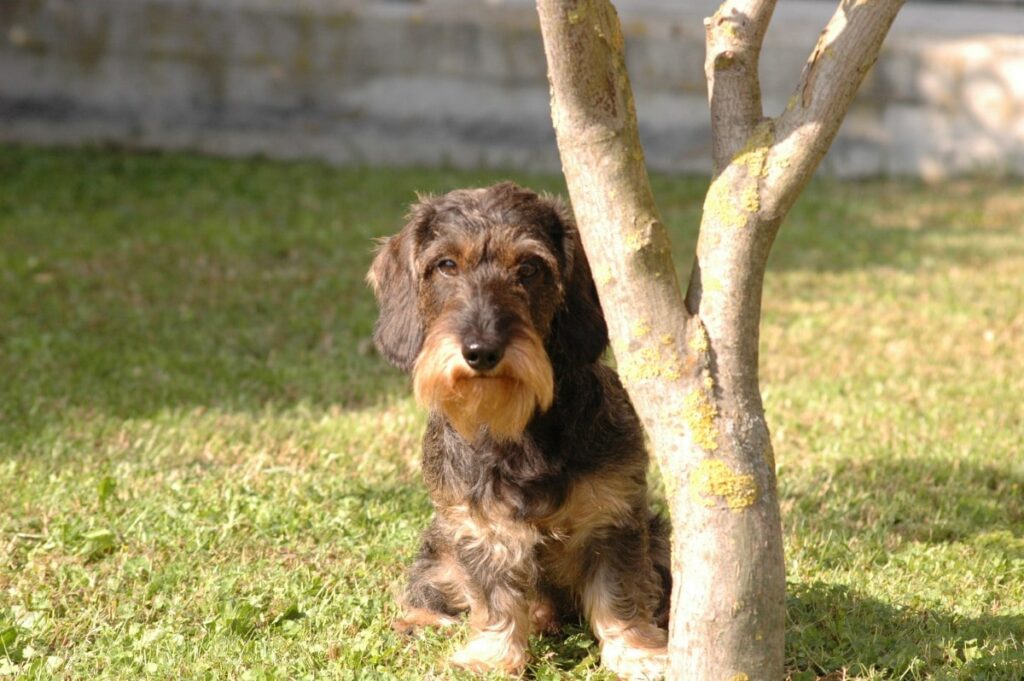
Does A Schnoodle Dog Shed?
Schnoodles are low to non-shedding dogs. This means that they do not shed very much, if at all. This is good news for people allergic to dog hair or who simply don’t want to deal with a lot of shedding. While all dogs shed some hair, Schnoodles shed less than most other breeds.
How Much Do Schnoodles Shed?
Schnoodles can range from low-shedding to non-shedding, depending on their coat type. The three types of coats that Schnoodles can have are wiry, soft, or curly. Wiry coats tend to shed the least, while curly coats tend to shed the most. Soft coats fall somewhere in the middle. No matter what type of coat your Schnoodle has, you can expect some shedding. However, it will probably be less than what you would see with other breeds of dogs.
What Causes Shedding in Schnoodle Dogs?
A few things can cause shedding in dogs: seasonal changes, stress, poor diet, and health problems. Seasonal changes (like summer to winter) can cause shedding because the dog’s body adjusts to the new weather conditions. Stress can also cause shedding because the dog’s body releases hormones that tell the hair follicles to stop growing. Poor diet and health problems can also lead to shedding because they can cause the hair follicles to become weak and fall out easily.
How Can I Reduce Shedding in My Schnoodle Dog?
You can do a few things to reduce shedding in your dog: brush regularly, give them a healthy diet, use supplements, and bathe them regularly. Brushing your dog’s coat regularly will help remove loose hair before it can fall out. Giving your dog a healthy diet will help its skin and coat stay healthy and strong. Supplements like omega-3 fatty acids can also help reduce shedding by keeping the skin and coat healthy. Finally, bathing your dog regularly will help remove any dirt or debris that could be causing the hair follicles to become weak and fall out easily.
What Are The Grooming Requirements Of The Schnoodle Dog?
The grooming requirements of the Schnoodle depend on the type of coat they have.
To remove dead hair and prevent matting, Schnoodles with a wiry coat must be brushed daily with a wire slicker brush. They should also be trimmed every 4-6 weeks by a professional groomer or their owner if they are comfortable doing so. These dogs do not need to be bathed as often as other dogs because their coat does not hold onto dirt and debris as much. Overbathing can strip the natural oils from their coat and cause skin irritation.
To remove tangles and prevent matting, Schnoodles with a soft coat will need to be brushed daily with a bristle brush. They should also be bathed every 2-4 weeks using a mild dog shampoo. After bathing, their coat should be dried thoroughly to prevent skin irritation. These dogs must also have their ears cleaned regularly to prevent infection.
Schnoodles with a curly coat must be brushed daily with a wide-toothed comb to remove tangles and prevent matting. They should also be bathed every 2-4 weeks using a mild dog shampoo. After bathing, their coat should be dried thoroughly to prevent skin irritation. These dogs will also need their ears cleaned regularly to prevent infection. In addition, curly-coated Schnoodles will need their coats trimmed every 4-6 weeks by a professional groomer or their owner if they are comfortable doing so.
No matter what type of coat your Schnoodle has, they will all need their nails trimmed regularly (about once per week). If you can hear their nails clicking on the floor when they walk, they need to be trimmed! You can either do this at home or take them to a professional groomer.
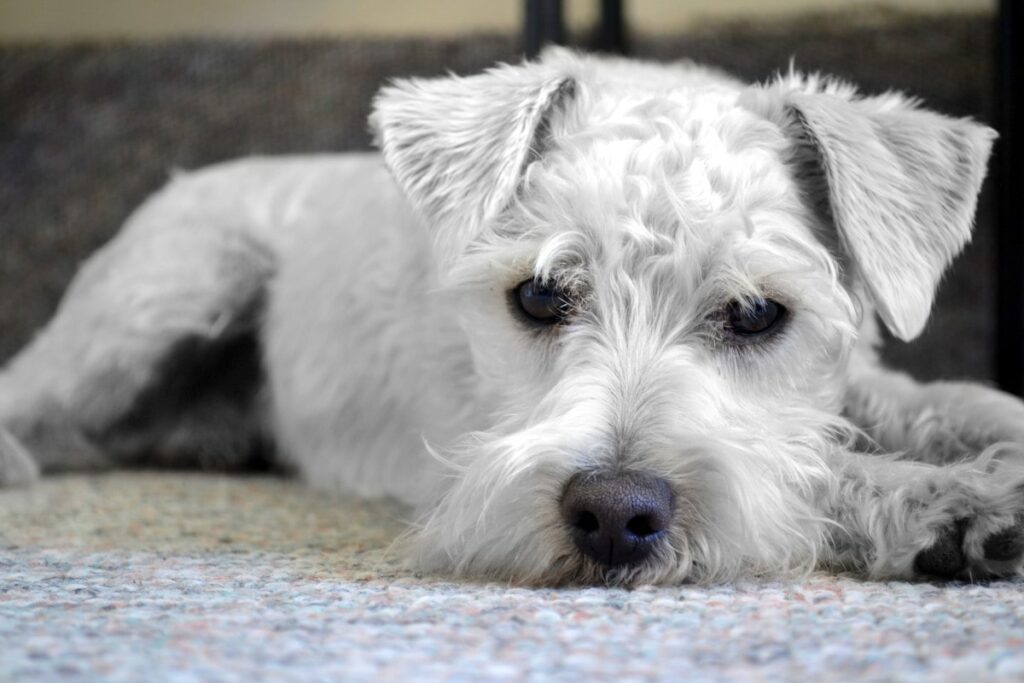
What Health Conditions Does a Schnoodle Dog Have?
Like all breeds, Schnoodles are prone to specific health conditions. Here are some of the most common health conditions seen in Schnoodles:
- Allergies: Allergies are one of the most common health problems in Schnoodles. They can be caused by environmental allergens such as pollen, dust, or food allergies. Symptoms of allergies include itching, redness, and hair loss.
- Ear Infections: Ear infections are common in dogs with floppy ears, such as Schnoodles. This is because the earflap traps moisture and dirt, which can lead to infection. Symptoms of an ear infection include shaking the head, scratching at the ears, and discharge from the ears.
- Eye Problems: Eye problems are relatively common in Schnoodles. Some of this breed’s most common eye problems include cataracts, glaucoma, and progressive retinal atrophy (PRA). Symptoms of eye problems vary depending on the condition but can include redness, discharge, squinting, and blindness.
- Hip Dysplasia: Hip dysplasia is a condition that affects the hip joints. It is caused by a hip joint malformation, which can lead to pain and lameness. Hip dysplasia is more common in larger breeds of dogs, but it can also affect smaller breeds like Schnoodles. Symptoms of hip dysplasia include stiffness, lameness, and pain.
- Patellar Luxation: Patellar luxation is a condition that affects the kneecap (patella). The patella is dislocated from its normal position in the knee joint, which can cause pain and lameness. Patellar luxation is more common in small breeds of dogs like Schnoodles. Symptoms of patellar luxation include skipping, hopping, or lameness in the affected leg.
If you are considering getting a Schnoodle dog, talk to your veterinarian about these conditions and how to best prevent them.
What Exercise Is Required For The Schnoodle Dog?
All three sizes of Schnoodle require moderate exercise, such as a daily walk or playtime in the yard.
The Standard Schnoodle is the largest of the three sizes and therefore requires more exercise than the Miniature or Toy. However, all three sizes need at least 30 minutes of exercise per day. This can be divided into two or three shorter sessions throughout the day. It’s best to take your Schnoodle for a walk in the morning before breakfast and in the evening after dinner. This will help to settle them down for the night and prevent them from becoming restless.
Schnoodles are intelligent dogs and therefore require mental stimulation and physical exercise. One way to provide this is through dog sports such as agility, obedience, flyball, or tracking. Alternatively, you can give your Schnoodle interactive toys to keep their minds active. For example, Kongs stuffed with treats or puzzle toys that they have to figure out how to get the treat out of.
Schnoodles are generally healthy dogs with a lifespan of 10-12 years. However, like all breeds, they are susceptible to specific health conditions such as hip dysplasia, von Willebrand’s disease, Addison’s disease, epilepsy, and patellar luxation. Therefore, it’s essential to consult with your veterinarian about what type and level of exercise are appropriate for your dog based on its health status.
How Much Space Is Required For A Schnoodle Dog?
Schnoodles need moderate exercise and do well in apartments or houses with small yards. A daily walk or play session is sufficient for this breed.
Who Is The Ideal Owner Of A Schnoodle Dog?
The ideal owner of a Schnoodle is someone who is looking for a loyal and loving companion. Schnoodles are known for their loyalty and affection towards their owners and make great family dogs. They are also relatively easy to train and are intelligent dogs, making them ideal for first-time dog owners.
Schnoodles require some exercise and must be taken on daily walks, but they only require a little space to run around. This makes them ideal for people who live in apartments or tiny homes. They are also relatively low-maintenance dogs regarding grooming, although they must be brushed regularly to prevent matting.
If you’re looking for a fun-loving, loyal, low-maintenance dog, then a Schnoodle is the perfect breed!
Pros of Owning a Schnoodle Dog
The Pros of Owning a Schnoodle Dog are:
- They make great family pets
- They are intelligent
- They are active
- They are playful
- They love being with people
- They are good with other animals
- They are low-shedding
- They do not require a lot of grooming
- They are generally healthy dogs
Cons of Owning a Schnoodle Dog
There are a few cons to owning a Schnoodle dog. They are:
- They require a lot of grooming. This breed mixes the Schnauzer and the Poodle, so they have a lot of hair! They will need to be brushed daily and visit the groomer every 6-8 weeks for a trim.
- They can be high energy. Schnoodles can have a lot of energy and may not be the best breed for someone looking for a low-key companion. They need daily exercise and will do best in an active home.
- They can be stubborn. Like any dog, Schnoodles can be stubborn at times. They need consistent training and socialization from an early age to ensure that they grow into well-rounded dogs.
- They may not be hypoallergenic. While Schnoodles are often advertised as being hypoallergenic, this is not always the case. Some individuals may still be allergic to their dander or saliva, so it is essential to test for allergies before bringing one home.
Should I Get A Male Or Female Schnoodle Dog?
When choosing a Schnoodle, you must decide whether you want a male or female dog.
Here are some things to consider when making your decision:
- Size – Male Schnoodles tend to be larger than females. A female might be the best choice if you’re looking for a smaller dog.
- Temperament – Male dogs are typically more independent than females and can be more stubborn. Females are usually more affectionate and easier to train.
- Energy Level – Both males and females, can have high energy levels, but males tend to have more stamina and need more exercise. A female might be the better choice if you’re looking for a couch potato.
- Health – Male dogs tend to be healthier than females and have fewer health problems. However, both genders are susceptible to specific health conditions such as hip dysplasia and von Willebrand’s disease.
- Cost – Female dogs are usually more expensive than males because they are in higher demand.
So, which is the best choice for you? It really depends on your personal preferences. A male Schnoodle might be the best choice if you want a giant dog with lots of energy. But a female might be the better option if you’re looking for a smaller, more affectionate dog.
What Colors Are Common For A Schnoodle Dog?
Schnoodles are a mix between a Poodle and a Schnauzer and can come in many colors. Some standard colors for Schnoodles are black, white, brown, and silver. However, because Schnoodles can be mixed with any type of Poodle, they can come in any color that Poodles do, including blue, grey, cream, apricot, and red. No one color is more common for Schnoodles than any other color.
Does A Schnoodle Dog Get On With Cats?
Schnoodles can get on well with other dogs and cats if socialized from a young age. However, because of their hunting instincts, they may chase smaller animals, such as rodents or birds. It is essential to provide your Schnoodle with plenty of toys and activities to keep them occupied. Otherwise, they may become bored and destructive.
Does The Schnoodle Dog Make A Good Guard Dog For The Home?
The Schnoodle is an intelligent dog that is easily trained. They are loyal and protective of their family and make good watchdogs, and will bark to alert you of strangers or strange noises. The Schnoodle is not aggressive but will defend its family if necessary.
The Schnoodle is a low-maintenance dog. They do not require much exercise and are content to lounge around the house all day. They are also relatively easy to groom but require regular brushing to prevent matting.
Overall, the Schnoodle makes an excellent guard dog for the home. They are intelligent, loyal, and easy to care for. The Schnoodle is an excellent choice if you are looking for a low-maintenance dog that will protect your family!
How Much Do Schnoodle Dog Puppies Cost?
The cost of a Schnoodle puppy varies depending on the size of the dog, the breeder, and the location. Standard Schnoodles typically cost between $600-$1,200, Medium Schnoodles cost between $700-$1,300, and Miniature Schnoodles cost between $800-$1,400. Some breeders may charge more for puppies with rare colors or markings.
Where Can You Find A Healthy Schnoodle Dog For Sale?
When looking for a healthy Schnoodle dog for sale, it is essential to consider the breeder’s reputation and health testing practices.
A reputable breeder will have extensive knowledge about the breed and can answer any questions. They will also have a written contract that outlines their health guarantee. Health testing is essential to ensure the puppy’s parents are free of genetic diseases.
The most common health tests for Schnoodles are hip and elbow dysplasia, von Willebrand’s disease, and eye exams. Puppies should also be up to date on their vaccinations and dewormings before going home.
When visiting a breeder, take note of the cleanliness of the facility and the health of the other dogs on the property. Ask to see the parents of the puppy you are interested in and ensure they are friendly and well-behaved.
Getting a referral from a trusted veterinarian or someone who has purchased a puppy from the breeder is also a good idea.
Schnoodle Dog Characteristics
The Schnoodle is a cross between the Poodle and the Schnauzer. The ideal Schnoodle combines the best characteristics of both breeds: the intelligence and non-shedding coat of the Poodle with the loyalty, playfulness, and watchdog ability of the Schnauzer.
Schnoodles come in three sizes: Standard (over 15 inches at the shoulder), Miniature (11-15 inches), and Toy (under 11 inches). They can be any color or combination of colors. The coat is usually curly or wavy and may be clipped in various styles. Some owners keep their Schnoodles’ coats long, which requires regular grooming to prevent mats and tangles.
Schnoodles are intelligent dogs that are easy to train. They are also active and playful and make great family pets. Like all dogs, they need plenty of exercise and attention. Schnoodles are generally healthy dogs, but like all breeds, they are susceptible to specific health conditions. These include hip dysplasia, von Willebrand’s disease, and epilepsy.
Schnoodles make great companion dogs. They are loyal and affectionate and bond closely with their families. They are also good watchdogs, as they will bark to alert you to strangers or unusual noises. Schnoodles are generally good with children and other pets, although some individual dogs may be shy or aggressive.
The Schnoodle may be the perfect breed for you if you are looking for a loving, loyal companion dog!
Final Thoughts: Is a Schnoodle Dog the Right Dog for You?
A Schnoodle is a cross between a Miniature Schnauzer and a Poodle. They are intelligent and active and make great family pets. However, they do require regular grooming and exercise. If you are considering adding a Schnoodle to your family, here are a few things to keep in mind.
Schnoodles are brilliant dogs that excel at obedience training. They are also very active and need plenty of exercises. A daily walk or run is a must, along with some playtime in the yard or at the park. Without enough physical and mental stimulation, Schnoodles can become bored and destructive.
Schnoodles do not shed much, but they do require regular grooming. Their coat should be brushed several times a week and must be clipped every few months. Schnoodles also need their teeth brushed regularly and their nails trimmed.
If you are looking for a loving, loyal companion that keeps you active, a Schnoodle may be the right dog. Just be sure to have the time and patience for regular grooming and plenty of space for exercise.

